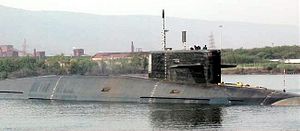The second Arihant-class nuclear-powered ballistic missile submarine (SSBN), the future INS Arighant (originally assumed to be named Aridhaman), was quietly launched at the Ship Building Center in Visakhapatnam in the Indian state of Andhra Pradesh on November 19, India’s Minister of Defense Nirmala Sitharaman revealed this week, according to local media reports.
The launch of the Indian Navy’s second indigenously designed and built SSBN comes a little over a year after the commissioning of the lead boat of the class, the INS Arihant. The Arihant-class’ design is based on the Russian Project 971 Akula I-class nuclear-powered attack submarine (SSN). Both the Arighant and Arihant were built with extensive Russian design and technical support.
The future INS Arighant is part of the Indian Ministry of Defense’s four-decade old Advanced Technology Vessel (ATV) project which aims to build a fleet of four to five SSBNs for the Indian Navy. The new Arihant-class will eventually constitute the sea leg of India’s strategic deterrent triad. India maintains nuclear warfare policy centered on a No First-Use (NFU) doctrine.
“As a result, New Delhi needs to field a credible second-strike capability. [As of now] India keeps its nuclear warheads de-mated from the actual missiles. However, in order for the new sub class to fulfill its role as the sea leg of India’s nuclear triad, SLBMs with mounted nuclear warheads will need to be deployed on the boomers,” I explained in February 2016.
The INS Arihant will likely not be used for nuclear deterrence patrols and primarily serve as a training platform for future submarine crews and as a general technology demonstrator.
The INS Arighant’s reactor was fueled in January and is expected to go critical in the coming months following a round set of sea trials evaluating the new SSBNs general seaworthiness. As I reported in October:
The [Arighant’s] will purportedly have a more powerful reactor than the 6,000-ton Arihant and also be slightly bigger. In addition, compared to the lead boat of the class the [Arighant’s] will have double the number of missile hatches, with eight launch tubes rather than the Arihant’s four.
The [Arighant’s] will also carry more advanced sensors than its sister boat and feature the indigenously-developed USHUS integrated sonar system and the Panchendriya sonar, a unified submarine sonar and tactical control system used for detecting and tracking submarines, torpedoes, as well as underwater obstacles. It can also be used for underwater communication.
The new SSBN can be armed with up to eight K-4 missiles, an intermediate-range nuclear-capable submarine-launched ballistic missile (SLBM). India’s Defense Research and Development Organization (DRDO) is also working on K-5 intermediate (possible intercontinental)-range and K-6 intercontinental range SLBMs for the Arihant-class. The K-4 has an estimated range of up to 3,500 kilometers, whereas the K-5 and K-6 are expected to have maximum ranges of 5,000 and 6,000 kilometers respectively.
For self-defense, the INS Arighant will carry 533-millimeter torpedoes—at least in theory for now. as I explained in October:
[F]ollowing the cancellation of a $200 million contract for 98 Black Shark heavyweight torpedoes at the end of May, the [SSBN] may not have the capability to defend itself against enemy subs for a number of years.
A second batch of 49 Black Shark torpedoes was also to be installed aboard India’s domestically developed and built Arihant-class of nuclear-powered ballistic missile submarines. According to Indian media reports, at least three of India’s future fleet of four to five Arihant-class SSBNs were expected to carry the new torpedoes. The cancellation of the order could mean a two- to three-year delay in the launching of the second sub of the class, the [Arighant ], due to torpedo tube modifications.
Alternative to the Black Shark torpedo are currently under evaluation.
The INS Arighant is expected to be commissioned in 2020-2021.
































